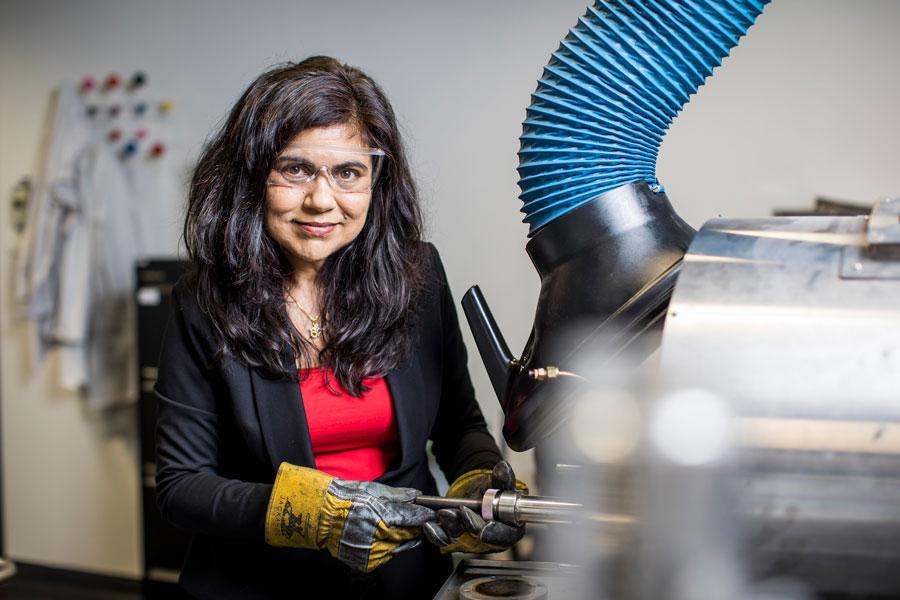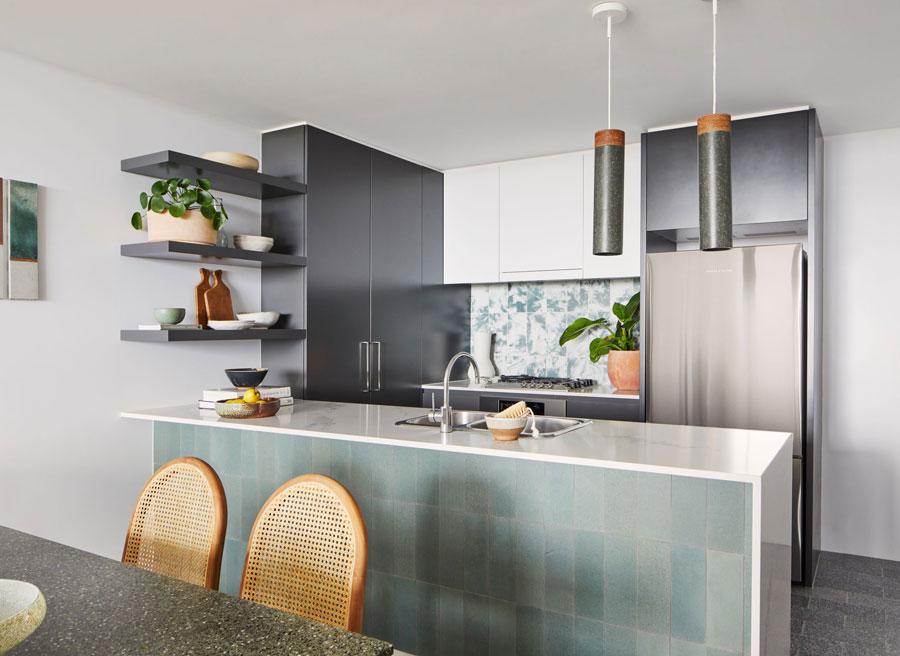Fighting macro problems, the micro way
Microfactories are 'turning traditional manufacturing on its head', says Professor Veena Sahajwalla, Director of the Centre for Sustainable Materials Research and Technology (SMaRT) at the University of New South Wales in Australia. Here, she chats to Shardell Joseph about her journey towards achieving a collective and circular economy using waste materials.

‘It's not just about the science, it's not just about technology, it's ultimately about, at that very basic level, understanding that we can all play a part in making sure that we take steps to heal our planet. And that healing is on so many different levels,’ Professor Veena Sahajwalla ponders.
‘We need to recognise that whether in Mumbai, or in Sydney, products and waste are all part of life, but how do we actually convert that into something that creates value for our society?’
Chatting to me from her post in Australia, she hypothesises how fundamental societal issues can be tackled by developing more localised supply chains using waste as feedstock in microfactories for a more sustainable collective economy.
‘I think what is so important in all of this is equity. Because in so many parts of the world, where you've got people in really disadvantaged communities working with waste, they don't necessarily get given fair wages, or have the same accessibility.’
Mumbai roots
Born in Mumbai, Veena’s perspective, passions and career have been shaped by her observations growing up. ‘I always get fascinated with the economy and life in Mumbai – so many people can actually be part of their entire ecosystem. You can have people who make things in big factories to people who repair clothes in a little corner of the city. Growing up in Mumbai, that was one of the things I really did enjoy, watching how life was just happening, where you can see everybody is playing a very important role. ‘What is fascinating is people are so entrepreneurial…in places like India, you wouldn't even think about throwing away your old pair of shoes because the normal thing to do is to repair them…out of need and necessity – I think there's a lot to be learned from that.’
Veena has spent the last decade connecting the dots between her experiences in Mumbai, her career in materials science and engineering, and her environmental and societal goals. ‘We have to learn to value that our environment has actually taken a lot of beating, we've been throwing away a lot of things and a lot of our end-of-life products seem to be just disposable. That cannot be sustained on our planet.
‘I think as materials scientists and engineers, we do have a role to play to challenge the norm, that visual way of thinking where everything's just going to be made – the way we design and the way we think about what kind of materials go into making a product has to be taught from the point of view of that entire sustainability question. It should never end up polluting our environment.
‘And then the question of equity comes in,’ Veena muses. She highlights how waste recovery needs to be considered from a breadth of different economic and social backgrounds. ‘If we want to create a whole new way of thinking about renewable materials, then we need to also know from the very beginning that any technological solutions that we develop have to be developed in a way that is accessible and affordable for everyone. To me, that's so important.’
Chain reaction
Around a decade ago, the seed of the microfactory concept was planted. Veena confides how the idea grew, despite initial resistance. She has since built a micro-ecosystem with the goal of repurposing, reusing and reforming materials, as well as using the skills and resources from local areas.
A microfactory is one or a series of small machines and devices that apply patented technology to perform one or more functions to transform waste products into new and usable resources. According to the SMaRT Centre team, the microfactories are capable of promoting and supporting viable local economies and jobs, working as part of the global value chain.
Veena explains, ‘The way we think about microfactories is that it's effectively about having a modular set-up. And in a modular set-up, you might have different modules that do different functions. The reason why I wanted to have it set up that way is that there's enough flexibility in there if you had, let's say, two or three towns or two or three businesses who wanted to collaborate and work together, but each in their own right did not have enough capital.
‘So, you can imagine that as a shared solution. Between three or four different organisations, they might decide that ‘look, I'll set up one module…where I'm supplying you this particular material, you've got the next module’, and then somebody else down the chain has got another module to make the finished product.
‘I used to do a lot of these experiments in our labs, and there will always be sceptics who say, ‘these experiments are working in the lab, fantastic, but you know what, they'll never work in the real world’.
‘I went to [the University of New South Wales, Australia] and I said we need to set up a machine that can do slightly bigger things…And that meant asking, what is it that you need to do to make something viable…not just always thinking that bigger is always better, but what is the right scale? And what is fit for purpose if the purpose is to make a high-quality ceramic product? And if I know I can recycle my waste and use that as a feedstock…that's a big win for the environment.’
In 2018, Veena and her team launched what they say is the world’s first microfactory at the University, transforming components from electronic waste (e-waste), such as discarded smart phones and laptops, into materials for reuse.
The system has several small modules that fit into a small site. The discarded devices are first placed into a unit to break them down. The next module may involve a special robot to identify useful parts. Another then comprises a small furnace that transforms the metal parts into valuable alloy materials by using a precisely controlled temperature process developed via extensive research.
The resulting materials include metal alloys and a range of micromaterials that can be deployed in industrial-grade ceramics, while the plastics are put through another module that produces filaments suitable for 3D-printing applications.
‘That’s the whole supply chain of materials, how we collect and how we process it, how we refine it, and ultimately use it in manufacturing, doing it on a scale where it makes sense to have a collective economy, empowering those local businesses that might not have thought about it.’
By laterally integrating many different operators, Veena explains how her concept defies the traditional model for manufacturing. ‘You think about manufacturing as a vertically integrated system…one business that has control, and they've got the size and they always want to talk about economies of scale. It's all about, ‘how can I make it cheaper?’ and, ‘how can I make it on a larger scale?’
‘The reason why I want to challenge that notion is that if you were to turn that upside down, and talk about lateral integration, you can actually connect various partners who would have normally never thought about making those products because they never thought that they had the capacity, the money or the ability to do that. Whereas now you are suddenly bringing it in. I like to think about it as the democratisation of manufacturing. You can imagine lots and lots of small businesses and communities participating to create a regional solution.’

A diversity of inspiration
Veena admits that part of her enthusiasm comes from a desire to inspire others, to potentially have a knock-on effect for continuing innovation in the field. ‘It can be any little thing that might inspire you – this is why I'm very passionate about making sure that we can help young people in their journey.
‘As professionals in this field of materials science and engineering, we can play a very important role in the way we shape the future and hopefully inspire the public as well…talking about science in a way that is relatable.
‘The reason why there is some degree of satisfaction and happiness in what I do is you feel that you've actually achieved something – whether it’s about wages, or about sustainability, all of these things, people in their own way want to do the right thing and want to make a difference. I think people are just looking for inspiration. And it can come from anywhere.’
Reflecting on the diversity of minds within her team, Veena shares how collaborating with people from a range of backgrounds is so important. ‘I look at someone like myself and my upbringing in Mumbai. And then I've got people who, of course, might have come from different parts of the world and people who bring their own experiences into the conversation.
‘That's one part of our thinking, but also there’s the skills we have and passion we have. For people who might range from chemists to materials scientists and engineers, one thing we all have in common is the values that we share. We are all so passionate about how we can make the planet more sustainable and make it so that we allow for equity and access to some of the basics that so many people just do not have access to.
‘You’ve got to be able to see the impact of your work on communities, whether it is your local community or a global community. To me, some of that empathy needs to be built into how we see other people and their lives – that must shape what we do. Not to see it as a materials science question, it's a materials for humanity question, we should never forget that.’
Injecting polymers into steel
Professor Veena Sahajwalla has developed a patented green steel technology, whereby hydrogen and solid carbon are extracted from end-of-life rubber tyres and waste plastic as an alternative to coke and coal needed for steelmaking.
The technology involves injecting polymer into the steelmaking process. Veena says a mixture of coke and recycled polymers produces a more stable foamy slag compared to coke only. The research team note this has greatly improved furnace energy efficiency and yield, while reducing raw material cost without detriment to furnace functioning or the finished product.
The process involves using waste materials that are granulated and then converted by the team into the polymer material injected into the Electric Arc Furnace.
‘It's the rubber that contains all these other elements,’ says Veena. ‘It's the tyres that give you these other molecules like hydrogen which then participate in the reaction, and that's what allows us to convert the iron oxide into iron which is what becomes steel.’
The polymer injection technology is in commercial production, installed into Electric Arc Furnace processes – two in Australia and five other international sites.







